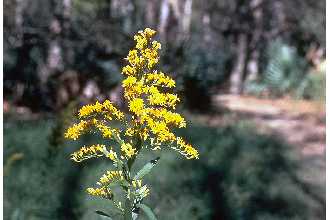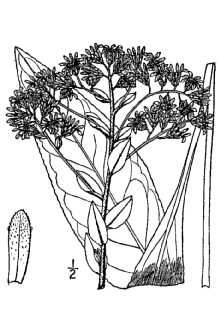Solidago grandiflora Raf.
Scientific Name: Solidago grandiflora Raf.

| General Information | |
|---|---|
| Usda Symbol | SOGR5 |
| Group | Dicot |
| Life Cycle | Perennial |
| Growth Habits | Forb/herb |
| Native Locations | SOGR5 |
Plant Guide
Use soil moisture sensors to measure the soil moisture of Solidago grandiflora Raf..
Fact Sheet
Alternate Names
Solidago rigida L., rigid goldenrod
Uses
Stiff goldenrod can be used for roadside plantings, wildlife food and habitat, and wildflower gardens because of its attractive bright yellow flowers, and as a small component of seeding mixtures for prairie restoration.
Status
Please consult the PLANTS Web site and your State Department of Natural Resources for this plant’s current status (e.g. threatened or endangered species, state noxious status, and wetland indicator values).
Description
Stiff goldenrod is a native perennial recognized by its broad, flat-topped inflorescence (cluster of flowers). The plant is a member of the Asteraceae, or aster family. It attains a height of over one meter. It flowers during the fall. The goldenrod flowers are like miniature asters and are all yellow. They are arranged in an inflorescence which is about 15 cm across and flat across the top. The leaves of goldenrod are stiff, rough textured and are alternately arranged on the stem. The leaves on the lower part of the plant are oblong and have short petioles. The upper leaves are lance-shaped and stalkless; there are also longer basal leaves that overwinter. Stiff goldenrod is more palatable than other members of the goldenrod group but is still infrequently grazed. It behaves in a prairie as an invader, i.e. it tends to come into pastures in greater amount when the prairie has been weakened by grazing.
Adaptation and Distribution
Distribution , Use soil moisture sensors to measure the soil moisture of Solidago grandiflora Raf..
Distribution
Goldenrod grows in prairies and dry woods from Massachusetts to Saskatchewan, south to Texas and Georgia. For a current distribution map, please consult the Plant Profile page for this species on the PLANTS Website.
Establishment
Prepare a clean weed free seedbed by disking and harrowing. Firm the seedbed by cultipacking. The seedbed should be firm enough to allow the seed to be planted ¼ inch deep. A seeder with a legume box works well in the seeding operation, although other types of seeders or drills may be used. Stiff goldenrod is easily propagated from seed. Seed sown in spring will produce transplants in one season. For permanent plantings, use transplants in fall or spring. Plants are largely cross-pollinated. Fertilizer: Apply no fertilizer during the establishment year unless soil test indicates a severe deficiency of potassium and/or phosphorus. Use no nitrogen during the establishment year as this can encourage weed competition. Seeding Rates: Adequate seeding rates for stiff goldenrod should be about ¼ pound of pure live seed (PLS) in a mixture. One pound (PLS) per acre is sufficient for seed production plantings. There are approximately 770,000 clean seeds in one pound of stiff goldenrod. Seeding Dates: Sow unstratified seed in the fall, November to March, stratified seed in the spring, April to May.
Plant Traits
Growth Requirements
| Temperature, Minimum (°F) | -43 |
|---|---|
| Adapted to Coarse Textured Soils | Yes |
| Adapted to Fine Textured Soils | No |
| Adapted to Medium Textured Soils | Yes |
| Anaerobic Tolerance | None |
| CaCO3 Tolerance | Medium |
| Cold Stratification Required | No |
| Drought Tolerance | High |
| Fertility Requirement | Medium |
| Fire Tolerance | High |
| Frost Free Days, Minimum | 80 |
| Hedge Tolerance | None |
| Moisture Use | Medium |
| pH, Maximum | 7.5 |
| pH, Minimum | 5.0 |
| Planting Density per Acre, Maxim | 11000 |
| Planting Density per Acre, Minim | 4800 |
| Precipitation, Maximum | 60 |
| Precipitation, Minimum | 14 |
| Root Depth, Minimum (inches) | 12 |
| Salinity Tolerance | None |
| Shade Tolerance | Intermediate |
Morphology/Physiology
| After Harvest Regrowth Rate | Moderate |
|---|---|
| Toxicity | None |
| Resprout Ability | No |
| Shape and Orientation | Erect |
| Active Growth Period | Spring and Summer |
| Bloat | None |
| C:N Ratio | High |
| Coppice Potential | No |
| Fall Conspicuous | No |
| Fire Resistant | No |
| Flower Color | Yellow |
| Flower Conspicuous | Yes |
| Foliage Color | Green |
| Foliage Porosity Summer | Dense |
| Foliage Porosity Winter | Porous |
| Fruit/Seed Color | Brown |
| Nitrogen Fixation | None |
| Low Growing Grass | No |
| Lifespan | Moderate |
| Leaf Retention | No |
| Known Allelopath | No |
| Height, Mature (feet) | 3.6 |
| Growth Rate | Rapid |
| Growth Form | Rhizomatous |
| Fruit/Seed Conspicuous | No |
| Foliage Texture | Coarse |
Reproduction
| Vegetative Spread Rate | Rapid |
|---|---|
| Small Grain | No |
| Seedling Vigor | Medium |
| Seed Spread Rate | Slow |
| Fruit/Seed Period End | Fall |
| Seed per Pound | 1009000 |
| Propagated by Tubers | No |
| Propagated by Sprigs | Yes |
| Propagated by Sod | No |
| Propagated by Seed | Yes |
| Propagated by Corm | No |
| Propagated by Container | No |
| Propagated by Bulb | No |
| Propagated by Bare Root | Yes |
| Fruit/Seed Persistence | No |
| Fruit/Seed Period Begin | Summer |
| Fruit/Seed Abundance | High |
| Commercial Availability | No Known Source |
| Bloom Period | Late Summer |
| Propagated by Cuttings | No |
Suitability/Use
| Veneer Product | No |
|---|---|
| Pulpwood Product | No |
| Protein Potential | Low |
| Post Product | No |
| Palatable Human | No |
| Palatable Graze Animal | Low |
| Palatable Browse Animal | Low |
| Nursery Stock Product | No |
| Naval Store Product | No |
| Lumber Product | No |
| Fodder Product | No |
| Christmas Tree Product | No |
| Berry/Nut/Seed Product | No |

